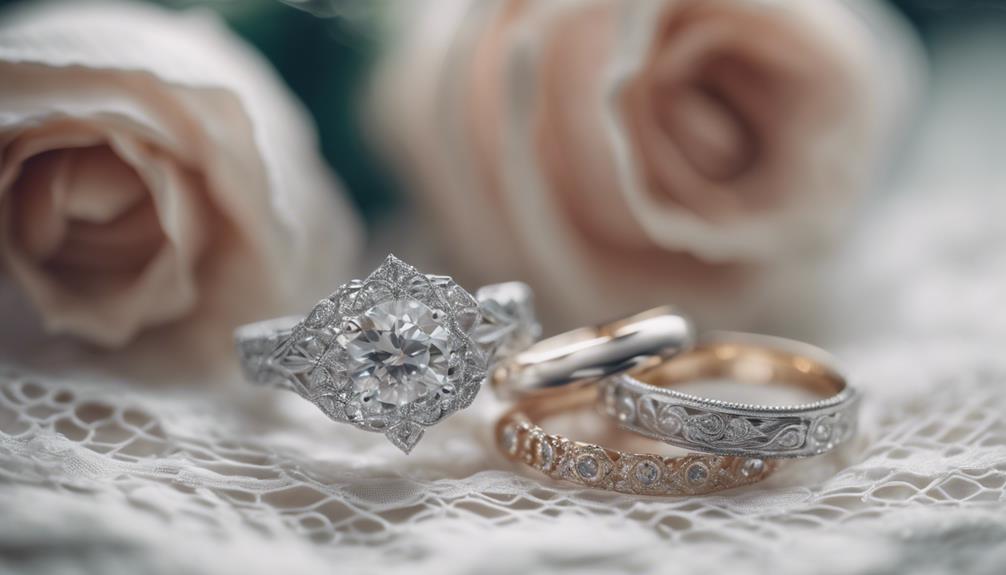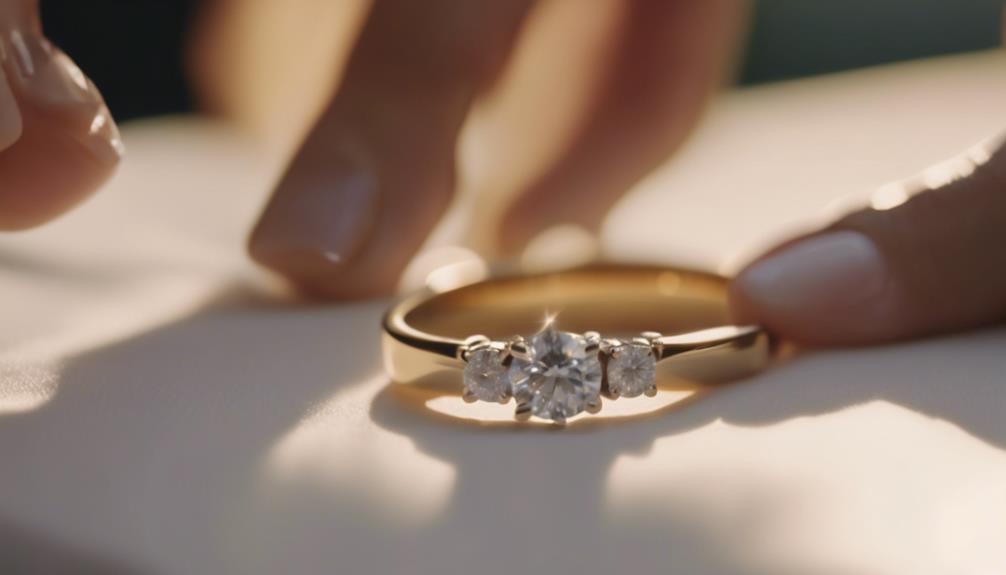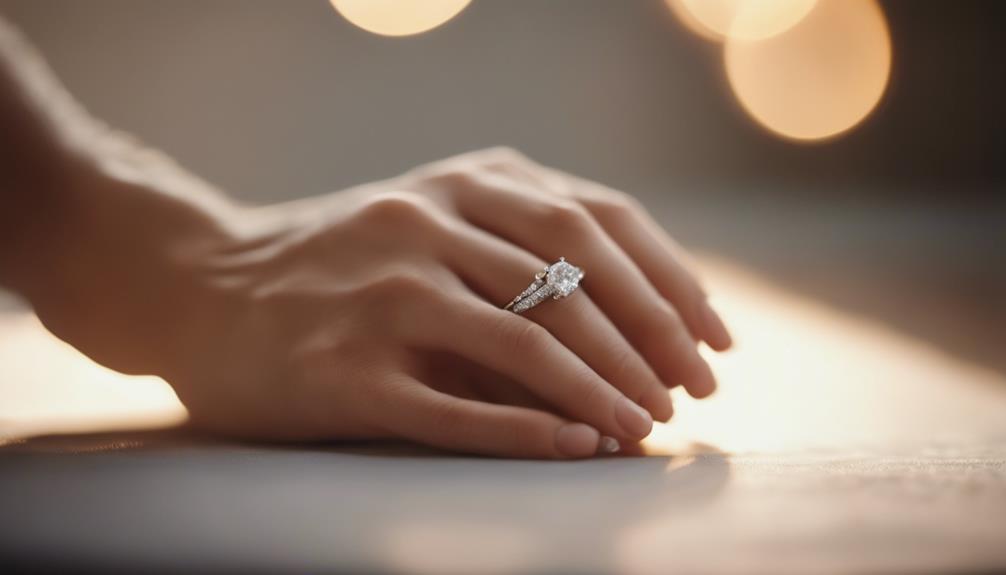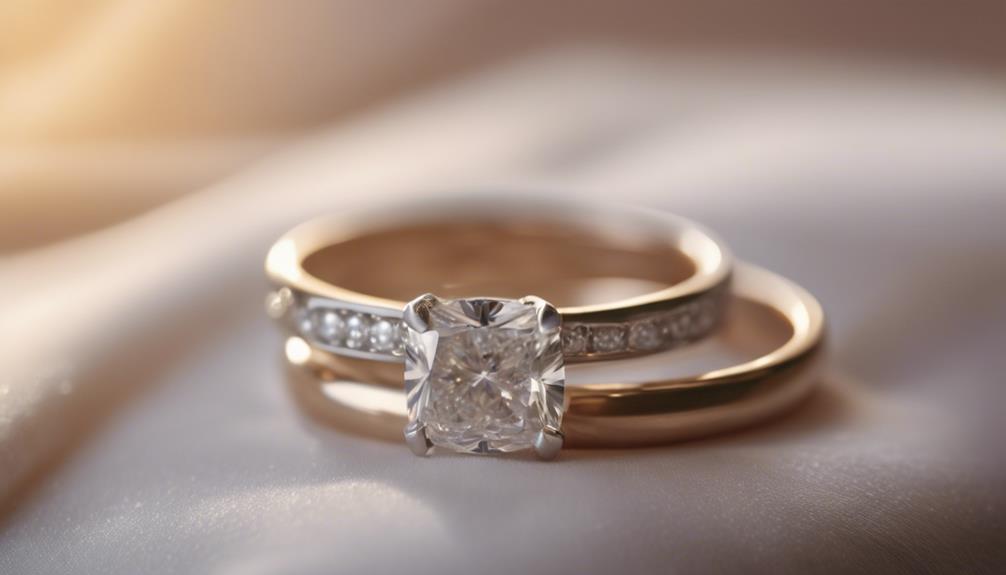An engagement ring marks the promise of marriage, typically featuring a prominent center stone like a diamond. You wear it after the proposal, symbolizing your intention to marry. In contrast, a wedding ring is exchanged during the marriage ceremony, signifying your official union. It’s generally simpler and designed for daily comfort. The engagement ring is often more expensive due to intricate designs, while wedding bands are more affordable. You’ll wear the engagement ring on your left hand until your wedding day, then add the wedding band. Want to understand all the details about these meaningful symbols in your relationship? Keep exploring.
Purpose and Symbolism

An engagement ring symbolizes the promise of marriage and commitment, while a wedding ring signifies the official union of the couple during the marriage ceremony. When you give or receive an engagement ring, it’s a clear declaration of your intention to marry. This ring is typically presented during a proposal, encapsulating the excitement and anticipation of your journey towards marriage. The symbolism here is powerful; it’s a promise of the future, a commitment to a shared life ahead.
On the other hand, the wedding ring represents the fulfillment of that promise. Exchanged during the marriage ceremony, it signifies the official and sacred union between you and your partner. The wedding ring is a timeless symbol of your lifelong commitment and love. Unlike the often ornate engagement ring, the wedding ring is usually simpler, reflecting the pure, unending bond of marriage.
Both rings hold immense emotional value. The engagement ring marks the beginning of your journey towards marriage, while the wedding ring celebrates your union. Together, they tell the story of your love and commitment, each serving as a tangible reminder of your promises and the enduring bond you share.
Design and Features
While the symbolism of engagement and wedding rings speaks volumes, their distinct designs and features also play a significant role in setting them apart.
An engagement ring typically dazzles with a dominant center stone, often a diamond, set in an intricate design. These rings capture attention with their elaborate settings, which may include side stones, halos, and detailed metalwork. The diamond’s cut, clarity, and carat weight are often the focal points, making the engagement ring a true statement piece.
On the other hand, a wedding band is generally simpler and more understated. Designed for everyday wear, wedding bands often feature minimal embellishments. You might find subtle designs like milgrain or pavé settings, yet the focus remains on durability and comfort. The cost difference reflects this simplicity, with wedding bands usually ranging from $500 to $2,500, compared to the $1,000 to $5,000 average for engagement rings.
While you wear your engagement ring on your left hand’s ring finger until the wedding day, the wedding band is added during the ceremony and worn closest to the heart. Together, these rings complement each other, marking different milestones in your journey of love and commitment.
Timing of Giving

The timing of giving an engagement ring and a wedding ring reflects the natural progression of a relationship. When you present an engagement ring during a proposal, it marks the beginning of a new chapter filled with promise and commitment. This moment is filled with anticipation and joy, as it signifies your intention to marry.
The wedding ring, on the other hand, is exchanged at the wedding ceremony, symbolizing the formal union of two people who’ve decided to spend the rest of their lives together.
Receiving an engagement ring is an emotional milestone that signifies:
- A promise of a future together
- The excitement of planning a wedding
- The joy of sharing the news with loved ones
The wedding ring is exchanged at the altar, solidifying the commitment that was initially promised with the engagement ring. This ring is intended to be worn continuously as a daily reminder of the vows exchanged and the love that binds you.
Cost Comparison
Engagement rings generally cost more than wedding bands due to their larger stones and intricate designs. When you’re looking at engagement rings, you’ll notice they typically feature a prominent center stone, often a diamond, which considerably drives up the price.
The cost of engagement rings usually falls between $1,000 and $5,000, with an average around $6,350. This higher price tag is due to the size and quality of the center stone, as well as the detailed craftsmanship involved.
In contrast, wedding bands are generally more affordable. You’ll find that wedding bands average between $500 and $2,500, with male wedding bands often costing around $500.
The simpler design of wedding bands, which typically focus more on the metal and occasional smaller accent stones, accounts for the lower cost. The cost comparison between engagement rings and wedding bands clearly shows a considerable price difference, with wedding bands often representing about 10% of the cost of engagement rings.
Understanding this price difference can help you budget appropriately for both rings. When you’re planning your purchase, keep in mind that the center stone and design intricacies of engagement rings account for their higher cost compared to the simpler, more affordable wedding bands.
Wearing Traditions

Understanding the price difference between engagement rings and wedding bands can guide your budget, but it’s equally important to know how these rings are traditionally worn.
Typically, the engagement ring is worn on the left hand’s fourth finger before the wedding, symbolizing your promise of marriage. During the wedding ceremony, the wedding band is then placed on the same finger, signifying the official bond of marriage and love.
After the ceremony, you usually move the engagement ring back to the left hand, stacking it above the wedding band. This combination represents both your initial commitment and the enduring nature of your union. However, wearing traditions can vary widely based on personal preference and comfort. Some couples prefer unique stacking styles or even wearing the rings separately.
Here are some emotional moments you might feel:
- The joy of sliding the engagement ring onto your finger for the first time.
- The profound connection when exchanging wedding bands during the ceremony.
- The comfort of feeling both rings together, symbolizing different stages of your journey.
There aren’t strict rules, so wear your rings in a way that feels right for you.
Conclusion
By understanding the distinct purposes and designs of engagement and wedding rings, you’re well-equipped to choose symbols that perfectly represent your love story.
Engagement rings showcase your commitment with a stunning center stone, while wedding rings solidify your bond with timeless elegance.
Knowing these differences, you can make informed decisions that resonate with your journey together.
Embrace this exciting adventure, and confidently select the rings that encapsulate your unique love.



